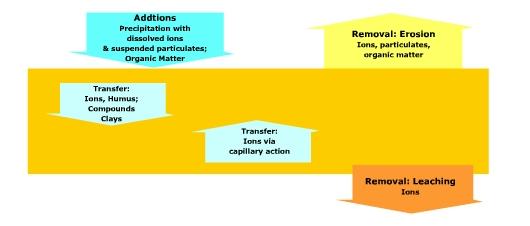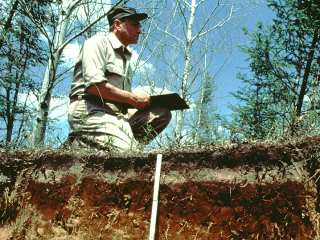Horizon Development ProcessesEver dug into in the soil and noticed how it seems to change color the deeper you go? Some soils are dark brown near the surface and get lighter in color as you go deeper. Others display a sandy, light-gray layer near the surface with a reddish layer beneath. These different colored layers are known as horizons. All the horizons taken together comprise the soil profile. Soil horizons form as a result of the four horizon development processes, additions, transformation, translocation, and removal. Figure 11.3 Horizon Development Processes AdditionsAdditions can be materials that are transported into the location where a soil is forming. For instance, dust with a high calcium carbonate content could be blown on to the developing soil adding calcium to the evolving profile. This is one idea as to how soils in the Midwestern part of the United States called mollisols were enriched with CaCO3. When plants die or leaves fall on to the surface they decompose adding organic matter to the soil.
TransformationTransformation of the materials added to the developing soil occur by chemical and biological processes acting on them. For instance, leaves falling on the surface and plant roots dying beneath may decompose into a dark brown, nutrient-rich material called humus. Humus is responsible for the dark brown to black color of many soils, especially near the top of the soil profile. Iron and aluminum can be oxidized under warm, moist climates. Soil material is constantly being transformed in one way or another. TranslocationTranslocation involves the movement of soil-forming materials through the developing soil profile. Translocation occurs by water running through the soil transferring materials from upper to lower portions of the profile. Burrowing animals like earth worms, ants, etc., move soil materials within the profile. Burrowing animals create passage ways through which air and water can travel promoting soil development. RemovalRemoval of soil forming materials means that they are completely removed from the soil profile. Easily dissolved elements like calcium carbonate can be removed from the soil profile under rainy climates. Soil horizons develop in response to the relative importance of each of the above processes. All soils are impacted by the horizon development processes to one degree or another. These processes determine the characteristics or properties of soil in each of the horizons. |

 Figure 11. 4 This
spodosol soil displays well-developed horizons. (Source: NRCS)
Figure 11. 4 This
spodosol soil displays well-developed horizons. (Source: NRCS)